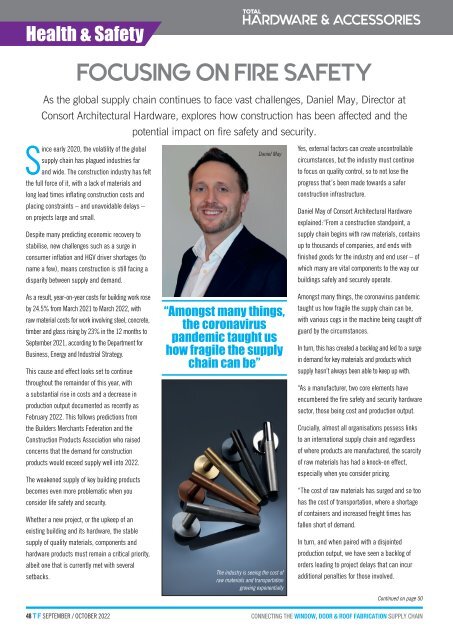September/October 2022
You also want an ePaper? Increase the reach of your titles
YUMPU automatically turns print PDFs into web optimized ePapers that Google loves.
Health & Safety<br />
HARDWARE & ACCESSORIES<br />
FOCUSING ON FIRE SAFETY<br />
As the global supply chain continues to face vast challenges, Daniel May, Director at<br />
Consort Architectural Hardware, explores how construction has been affected and the<br />
potential impact on fire safety and security.<br />
Since early 2020, the volatility of the global<br />
supply chain has plagued industries far<br />
and wide. The construction industry has felt<br />
the full force of it, with a lack of materials and<br />
long lead times inflating construction costs and<br />
placing constraints – and unavoidable delays –<br />
on projects large and small.<br />
Despite many predicting economic recovery to<br />
stabilise, new challenges such as a surge in<br />
consumer inflation and HGV driver shortages (to<br />
name a few), means construction is still facing a<br />
disparity between supply and demand.<br />
As a result, year-on-year costs for building work rose<br />
by 24.5% from March 2021 to March <strong>2022</strong>, with<br />
raw material costs for work involving steel, concrete,<br />
timber and glass rising by 23% in the 12 months to<br />
<strong>September</strong> 2021, according to the Department for<br />
Business, Energy and Industrial Strategy.<br />
This cause and effect looks set to continue<br />
throughout the remainder of this year, with<br />
a substantial rise in costs and a decrease in<br />
production output documented as recently as<br />
February <strong>2022</strong>. This follows predictions from<br />
the Builders Merchants Federation and the<br />
Construction Products Association who raised<br />
concerns that the demand for construction<br />
products would exceed supply well into <strong>2022</strong>.<br />
The weakened supply of key building products<br />
becomes even more problematic when you<br />
consider life safety and security.<br />
Whether a new project, or the upkeep of an<br />
existing building and its hardware, the stable<br />
supply of quality materials, components and<br />
hardware products must remain a critical priority,<br />
albeit one that is currently met with several<br />
setbacks.<br />
Daniel May<br />
“Amongst many things,<br />
the coronavirus<br />
pandemic taught us<br />
how fragile the supply<br />
chain can be”<br />
The industry is seeing the cost of<br />
raw materials and transportation<br />
growing exponentially<br />
Yes, external factors can create uncontrollable<br />
circumstances, but the industry must continue<br />
to focus on quality control, so to not lose the<br />
progress that’s been made towards a safer<br />
construction infrastructure.<br />
Daniel May of Consort Architectural Hardware<br />
explained:“From a construction standpoint, a<br />
supply chain begins with raw materials, contains<br />
up to thousands of companies, and ends with<br />
finished goods for the industry and end user – of<br />
which many are vital components to the way our<br />
buildings safely and securely operate.<br />
Amongst many things, the coronavirus pandemic<br />
taught us how fragile the supply chain can be,<br />
with various cogs in the machine being caught off<br />
guard by the circumstances.<br />
In turn, this has created a backlog and led to a surge<br />
in demand for key materials and products which<br />
supply hasn’t always been able to keep up with.<br />
“As a manufacturer, two core elements have<br />
encumbered the fire safety and security hardware<br />
sector, those being cost and production output.<br />
Crucially, almost all organisations possess links<br />
to an international supply chain and regardless<br />
of where products are manufactured, the scarcity<br />
of raw materials has had a knock-on effect,<br />
especially when you consider pricing.<br />
“The cost of raw materials has surged and so too<br />
has the cost of transportation, where a shortage<br />
of containers and increased freight times has<br />
fallen short of demand.<br />
In turn, and when paired with a disjointed<br />
production output, we have seen a backlog of<br />
orders leading to project delays that can incur<br />
additional penalties for those involved.<br />
Continued on page 50<br />
48 T F SEPTEMBER / OCTOBER <strong>2022</strong> CONNECTING THE WINDOW, DOOR & ROOF FABRICATION SUPPLY CHAIN

















